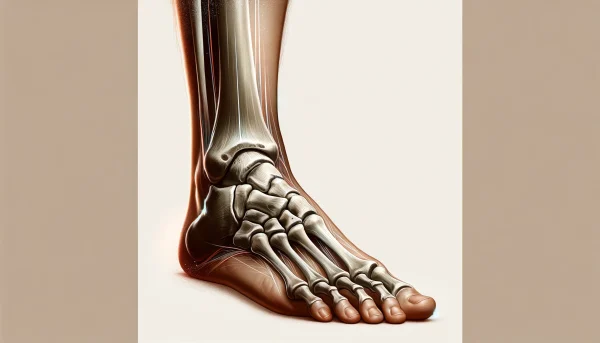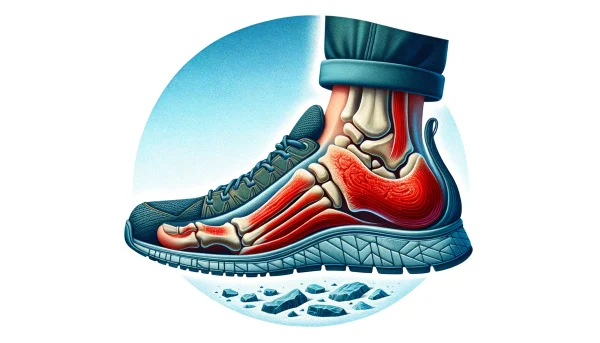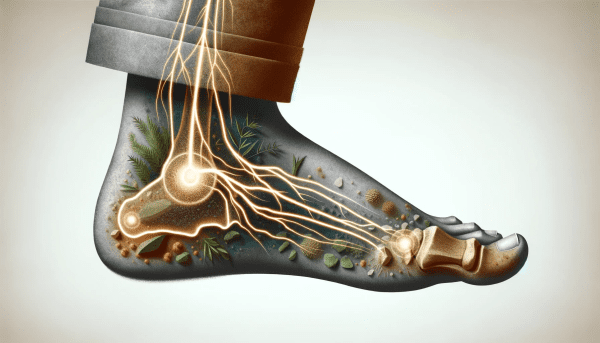Dealing with pain on top of foot can be a frustrating and, at times, a debilitating experience. Understanding the causes and knowing how to effectively manage or treat this discomfort is crucial for maintaining foot health and overall well-being.
In this comprehensive guide, we’ll explore the various factors that contribute to pain on the top of the foot, including specific conditions like stabbing pain, discomfort while walking or after running, and issues related to nerve and burning sensations.
Additionally, we’ll delve into the role of conditions like extensor tendonitis and bunions in this context. Then, we’ll provide practical strategies and methods to alleviate these types of foot pain.
What Causes Pain on the Top of Your Foot?

The foot is a complex structure consisting of bones, muscles, tendons, and ligaments, all of which are susceptible to various forms of stress and injury. Pain on the top of the foot can be caused by a range of factors:
Injuries: Sprains or Fractures
Sprains involve the stretching or tearing of ligaments, while fractures refer to breaks in the bones. The foot’s intricate bone structure, comprising 26 bones, makes it vulnerable to such injuries.
According to a study in the “Journal of Foot and Ankle Research,” foot sprains and fractures are often the result of accidental falls, sports injuries, or direct impacts.
Overuse: Repetitive Activities or Excessive Walking
Repetitive stress on the foot can lead to conditions like stress fractures or tendonitis. Activities like long-distance running or jobs requiring extended periods of standing contribute to this.
A 2020 study highlighted that repetitive impact on the foot’s bones and tendons could lead to micro-traumas, eventually causing pain.
Footwear: Ill-fitting or Unsupportive Shoes


Shoes that do not fit properly or provide inadequate support can lead to abnormal foot mechanics, resulting in pain.
Research in the Journal of the American Podiatric Medical Association showed a significant correlation between improper footwear and the development of foot disorders.
Medical Conditions: Arthritis, Diabetes, or Other Systemic Diseases
Types of Arthritis Affecting the Feet
- Osteoarthritis: The most common form, often affecting the big toe, midfoot, and ankle.
- Rheumatoid Arthritis: An autoimmune disease that can cause severe deformities in the feet due to joint damage.
- Psoriatic Arthritis: Often affects the toes, leading to swelling and pain, similar to gout.
Mechanisms of Pain and Discomfort
- Joint Inflammation: Causes pain, swelling, and stiffness in the foot and ankle.
- Joint Damage: Chronic arthritis can lead to the breakdown of cartilage and the development of bone spurs, further causing pain and mobility issues.
Research Insights
Studies published in the “Journal of Rheumatology” have shown that foot problems are prevalent in more than 90% of patients with rheumatoid arthritis, highlighting the need for targeted foot care in these patients.
Diabetes and Foot Complications


Diabetes, particularly when poorly controlled, can lead to serious foot problems.
Diabetic Neuropathy
- Nerve Damage: High blood sugar levels can damage the nerves in the feet, leading to loss of sensation, tingling, or pain.
- Research Findings: According to Johns Hopkins, approximately 50% of people with diabetes suffer from some form of neuropathy, with the risk increasing with the duration of diabetes.
Peripheral Arterial Disease (PAD)
- Reduced Blood Flow: Diabetes can lead to PAD, which reduces blood flow to the feet, causing pain and slowing wound healing.
- Clinical Correlations: Studies in “Vascular Medicine” have indicated a strong association between diabetes, PAD, and foot pain.
Increased Risk of Infections
- Wound Healing Issues: Diabetes can impair the healing process, leading to a higher risk of infections in the feet.
- Medical Observations: Diabetic foot ulcers and infections are significant complications, as noted in The Lancet, necessitating rigorous foot care and monitoring.
Other Systemic Diseases and Foot Pain
Several other systemic conditions can also lead to foot pain:
Gout
Causes acute pain, typically in the big toe, due to the formation of urate crystals in the joint. Gout and its impact on foot health have been extensively documented in rheumatology research.
Lupus
Lupus can cause joint pain and swelling in the feet, along with other systemic symptoms. Research in autoimmune diseases frequently links lupus with various foot problems.
Join our LUPUS Community Group online!


Fibromyalgia
This condition can cause widespread musculoskeletal pain, including in the feet. Studies in the field of pain management have explored the widespread pain experienced in conditions like fibromyalgia, often affecting the feet.
Peripheral Artery Disease
Circulatory Problems lead to reduced blood flow to the extremities, causing foot pain, especially during walking. The link between PAD and foot pain is well-established in vascular health studies.
Raynaud’s Disease
Blood Vessel Spasms can cause episodes of reduced blood flow to the feet, leading to pain and color changes in the skin. Clinical Findings: Raynaud’s disease and its effects on the extremities, including the feet, have been the subject of several medical studies.
Extensor Tendonitis: Inflammation of the Tendons


This condition involves inflammation of the tendons that straighten the toes, often due to overuse. Extensor tendonitis is frequently diagnosed in athletes and individuals with active lifestyles.
What Causes Stabbing Pain on the Top of Your Foot?
Stabbing pain on the top of the foot often indicates an acute injury or a sudden flare-up of an underlying condition. This type of pain can be sharp and intense, making it hard to walk or bear weight on the foot. Possible causes include:
Nerve Irritation: Compression or Damage
Nerves in the foot can become compressed or irritated due to injuries, inflammation, or tight footwear. Raj N. Sureja, MD highlighted that nerve compression could lead to acute, sharp pain sensations in the foot.
Tendon Strain: Acute Injury to the Extensor Tendons
Sudden or excessive force can strain the tendons, causing sharp pain. Sports medicine literature often cites tendon strains as a common injury among athletes, leading to sharp, stabbing pain.
Stress Fractures: Small Cracks in the Bones
Caused by repetitive force, often from overuse in sports or activities. Behrens et al reported that stress fractures are micro-fractures resulting from repetitive stress, common in runners.
What Causes Pain on Top of Foot When Walking
Walking can exacerbate certain conditions, leading to pain on the top of the foot. This discomfort is often due to:
Poor Foot Mechanics: Flat Feet or High Arches
Abnormal foot arches can distribute weight unevenly, causing pain. Studies in podiatric medicine show that individuals with flat feet or high arches are more prone to developing pain on top of foot when walking.
Tendonitis: Inflammation of Tendons
Overuse or improper foot mechanics can inflame tendons. A study in the Journal of Orthopaedic & Sports Physical Therapy identified tendonitis as a common consequence of repeated stress on foot tendons.
Improper Footwear: Shoes Lacking Support
Shoes without proper support can exacerbate foot pain while walking. Podiatric studies have consistently found a link between poor footwear choices and increased foot pain during walking.
What Causes Pain on Top of Foot Near Ankle
The proximity of the ankle to the top of the foot means that pain in this area can be due to issues affecting either structure. Common causes include:
Ankle Sprains: Ligament Injuries
These involve the tearing or stretching of ligaments connecting the foot and ankle. The “Journal of Athletic Training” reported that ankle sprains can contribute to pain in the top of the foot due to the interconnected nature of foot and ankle structures.
Tendon Overload: Strain on Ankle Tendons
Excessive use or sudden movements can strain tendons near the ankle. Orthopedic research has shown that tendon overload near the ankle can cause pain that radiates to the top of the foot.
Arthritis: Joint Inflammation
Arthritis in the ankle joint can cause swelling and pain that affects the top of the foot.
Research in “Arthritis Care & Research” journal has documented the impact of arthritis on adjacent foot areas.
What Causes Pain on Top of Foot After Running


Running is a high-impact activity that can lead to pain on the top of the foot, often caused by:
Overuse Injuries: Repetitive Impact Stress
Continuous impact from running can strain the foot’s bones and tendons. A study in “The Journal of Sports Medicine” outlined that repetitive impact during running is a primary cause of overuse injuries in the foot.
Tight Footwear: Compression from Running Shoes
Running shoes that are too tight can compress the top of the foot, leading to pain. Footwear science research indicates that improperly fitted running shoes can significantly contribute to top foot pain.
Poor Running Form: Technique Imbalances
Incorrect running technique can unevenly distribute stress across the foot. Biomechanical analyses in sports science literature reveal that poor running form can lead to increased strain on the foot.
What Causes Nerve Pain on Top of Foot
Nerve pain on the top of the foot can manifest as a burning, tingling, or stabbing sensation, often due to:
Neuropathy: Peripheral Nerve Damage
Conditions like diabetes can damage peripheral nerves, causing pain in the foot. Diabetic neuropathy studies have shown a direct link between nerve damage and foot pain.
Nerve Compression: Pressure from Shoes or Swelling
Tight footwear or swelling can compress nerves, leading to pain. Podiatric studies have identified nerve compression due to external pressure as a common cause of foot nerve pain.
Tarsal Tunnel Syndrome: Nerve Compression in Foot
This condition involves the compression of a nerve inside the tarsal tunnel of the foot. Research in “The Journal of Foot and Ankle Surgery” has highlighted tarsal tunnel syndrome as a significant cause of nerve pain in the foot.
What Causes Burning Pain on Top of Foot


Burning pain is typically nerve-related and can be due to:
Peripheral Neuropathy: Often Associated with Diabetes
Diabetes can lead to nerve damage, manifesting as burning pain. Studies on diabetic neuropathy have frequently documented burning sensations as a symptom.
Nerve Compression: From Tight Footwear or Injury
Tight shoes or injuries can compress nerves, causing a burning sensation. Compression of foot nerves due to external factors is well-documented as a cause of burning pain.
Inflammation: Seen in Conditions like Extensor Tendonitis
Conditions like extensor tendonitis can cause inflammation, leading to a burning sensation. Studies in sports medicine and podiatry have linked inflammation in foot tendons to burning pain sensations.
Can Bunions Cause Pain on the Top of Foot?
Bunions are not just a cosmetic concern but can have functional implications, including causing pain on the top of the foot.
Bunion Formation and Foot Mechanics: Bunions, or hallux valgus, are bony protrusions at the base of the big toe. They develop due to the misalignment of the first metatarsal bone and the big toe. This misalignment alters the biomechanics of the foot.
Impact on Extensor Tendons: As the bunion develops, it can lead to an imbalance in the foot’s structure, placing unusual strain on the extensor tendons located on the top of the foot.
Clinical Evidence: Studies in podiatric medicine, such as those published in the “Journal of Foot and Ankle Research,” have shown that bunions can lead to secondary conditions like extensor tendonitis, contributing to pain on the top of the foot.
How to Get Rid of Pain on Top of Foot
Managing pain on the top of the foot involves a combination of self-care measures, lifestyle changes, and, in some cases, medical intervention:
Rest and Ice: Reduces Inflammation and Pain
Rest: Minimizing activities that put stress on the foot allows the tissues to heal.
Ice Therapy: Applying ice packs reduces inflammation and numbs the pain. Research in “The Journal of Physiotherapy” suggests that ice therapy is effective in reducing soft tissue swelling and pain.
Elevation: Helps Decrease Swelling
Keeping the foot elevated above heart level reduces blood flow to the area, thus decreasing swelling. This is a widely recommended practice in sports medicine.
Footwear Adjustment: Switching to Shoes with Better Support
Well-fitted shoes with proper arch support and cushioning distribute pressure evenly across the foot, alleviating pain. Podiatry research has consistently highlighted the importance of appropriate footwear in managing foot pain.
Orthotics: Custom Insoles
Orthotics are tailored to individual foot structures and can correct biomechanical imbalances. Studies in orthopedic journals have shown that orthotics effectively alleviate pain and improve foot function.
Physical Therapy: Strengthens and Stretches Foot Muscles
Targeted exercises can strengthen foot muscles, improve flexibility, and reduce pain. Physical therapy’s effectiveness in managing foot pain is well-documented in medical literature.
Pain Relief Medications: Over-the-Counter Options
NSAIDs (Non-Steroidal Anti-Inflammatory Drugs) can relieve pain and reduce inflammation. Studies have shown that NSAIDs are effective for short-term pain relief in musculoskeletal conditions.
How to Get Rid of Stabbing Pain on the Top of Your Foot
For stabbing pain, specific strategies include:
Cold Therapy: Reduces Acute Inflammation
Application of cold packs helps in reducing inflammation and numbing the area, thus alleviating stabbing pain. Cold therapy is widely recommended in acute pain management, per sports medicine guidelines.
Compression: Supports the Area
Compression Wraps provide support, reduce swelling, and stabilize the foot’s structures. Compression therapy is a standard treatment in managing acute injuries, as documented in medical journals.
Avoiding Aggravating Activities: Reducing Stress on Foot
Limiting or modifying activities that exacerbate pain can prevent worsening of the condition. Guidelines in orthopedic care emphasize the importance of activity modification in injury recovery.
How to Get Rid of Pain on Top of Foot When Walking
Supportive Footwear: Essential for Arch Support
Footwear with proper arch support and cushioning can significantly reduce pain while walking. Studies in podiatric medicine have shown a positive correlation between supportive footwear and reduced foot pain.
Gradual Increase in Activity: Preventing Overuse
Gradually increasing walking or running distances helps avoid overuse injuries. Research recommends a gradual increase in physical activity to prevent overuse injuries.
Orthotic Inserts: Customized Support
They provide additional support and can correct alignment issues, reducing pain during walking. Multiple studies have validated the effectiveness of orthotic inserts in managing foot pain.
How to Get Rid of Pain on Top of Foot Near Ankle
Ankle Supports: Braces or Wraps
These devices can provide extra stability and reduce stress on the foot and ankle. Ankle supports are frequently recommended in orthopedic practice for managing ankle-related foot pain.
R.I.C.E. Method: Comprehensive Care Approach
Rest, Ice, Compression, and Elevation. This method is a cornerstone in treating soft tissue injuries and reducing pain. The R.I.C.E method is widely accepted and recommended in sports medicine and rehabilitation.
Gentle Exercises: Enhancing Mobility
Gentle stretching and strengthening exercises can improve range of motion and strength, thereby reducing pain. Clinical studies endorse gentle exercises as an effective way to recover from and prevent foot and ankle pain.
How to Get Rid of Pain on Top of Foot After Running
Proper Running Shoes: A Key to Pain Prevention
Well-fitted running shoes suitable for one’s foot type can prevent pain. Research in sports science emphasizes the importance of proper footwear in preventing running-related foot pain.
Post-Run Care: Essential Recovery Practices
Cool down and foot massages help in muscle recovery and pain reduction. Studies show that proper post-run care, including stretching and massages, is crucial in preventing foot pain.
Cross-Training: Diversifying Exercise
Incorporating low-impact exercises can give the feet a break from the stress of running. Cross-training is recommended to distribute physical stress and reduce the risk of overuse injuries.
How to Get Rid of Nerve Pain on Top of Foot
Nerve Glides: Relieving Nerve Compression
These exercises help in relieving nerve compression, thereby reducing pain. Nerve glide exercises are supported by neurophysiological research for their effectiveness in managing nerve pain.
Medication: Targeted Pain Relief
Medications specifically targeting nerve pain can be effective. Research supports the use of certain medications for targeted nerve pain relief.
Reducing Pressure: Minimizing Foot Stress
Avoiding tight shoes and minimizing activities that stress the foot can alleviate nerve pain. Lifestyle modifications are a key component in the management of nerve-related foot pain, as per clinical guidelines.
How to Get Rid of Burning Pain on Top of Foot
Cold Packs
Cold pack application can soothe burning sensations and reduce inflammation. The use of cold treatments for burning pain is well-supported in pain management literature.
Foot Baths: Improving Circulation
Warm Water Soaks can help improve circulation and alleviate burning sensations. Warm foot baths are often recommended for their therapeutic benefits in improving blood flow and reducing pain.
Neuropathic Pain Medication: Specific Drug Therapy
In cases related to neuropathy, certain medications can be prescribed for pain relief. Efficacy of neuropathic pain medications is well-documented in clinical pharmacology research.
Conclusion
Pain on the top of the foot is a condition that can stem from various causes, each requiring a tailored approach for effective management. By understanding the underlying reasons and adopting appropriate remedies, you can significantly alleviate discomfort and improve foot health.
Remember, persistent or severe pain should always be evaluated by a healthcare professional for an accurate diagnosis and treatment plan. Your feet are foundational to your overall health, so taking good care of them is paramount.




